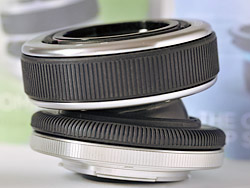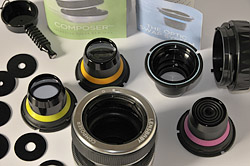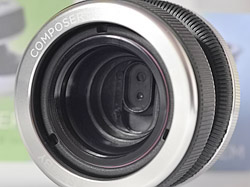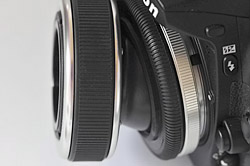MINIPHOTOKINA REVIEW
Lensbaby Composer --
Selective Focus Gets Hip
 By MIKE PASINI
By MIKE PASINIEditor
The Imaging Resource Digital Photography Newsletter
Review Date: September 2008
As part of our miniphotokina coverage, Lensbaby sent a prototype Composer for review. The Composer is a radically new design of the lens family famous for selective focus. That's selective focus within the plane of focus, not just among the planes of focus. With a Lensbaby you can pick one part of the frame to focus on, no matter where it is.
|
|
With a Lensbaby, you can also control how much is in focus with a set of aperture disks. The wider the aperture the less is in focus.
OPTIC SWAPPING | Back to Contents
But Lensbaby has completely redesigned the system, adding a new dimension to selective focus with an interchangeable optical system called the Lensbaby Optic Swap system. There are four swappable optics including a 50mm multi-coated optical glass doublet like the Lensbaby 2.0 and 3G, a 50mm uncoated optical glass singlet like the original Lensbaby, a 50mm plastic singlet that simulates a Holga and a pinhole/zone plate optic with an f/177 pinhole and an f/19 zone plate opening.
The included Optic Swap Tool (which doubles as a cap to the lens optics carrying case) is used to pop the installed optic out and lock the new optic in.

Dance Anyone? The Composer on its heels.
But wait! That's just the tip of the optic iceberg.
THE BALL JOINT | Back to Contents
The Composer represents a complete redesign (the third we counted) of the Lensbaby concept. And this one is as easy to use as a Fisher Price toy compared to the Rube Goldberg complexity of the 3G. We happen to be expert at handling Fisher Price toys, if the reference confuses you.
So we popped the Composer with the multi-coated optic onto our Nikon D200 and prowled around the neighborhood. We were immediately smitten with the new design. It was very easy to use -- not to mention fun.
The Lensbaby 2.0 required you to compress and tilt the front element of the lens with your fingers. The bellows would compress but not exactly hold any particular position. Still, it was functional and the results were amusing.

Optical Swap System. The Lensbaby Composer is surrounded by the yellow doublet, orange singlet, blue plastic and pink pinhole/zone plate optics. On the left are the aperture disks with the magnetic tool above them. On the right is the optic tool with three pins that fit into the notches you can see on the plastic optic to fit the Composer's locks visible just inside the chrome ring.
The 3G improved on that by being able to lock the lens in a particular orientation. That was a little confining -- you had to lock, unlock, lock -- but it gave you more control over focus than the 2.0 version with a fine focusing mechanism.
Between the squeeze and the lock, though, Lensbaby came up with a better way to handle selective focus. A ball joint. It's sort of like your hip joint's ball and socket.
You simply push the front element of the lens one way or the other to focus on one part of your frame or the other. It stays where you push it. And you can adjust the how tight the ball joint is with the black ring closest to the lens mount. It's not an adjustment you have to make all the time, though. We set it to our liking and didn't find it necessary to change because the front element was both easy to move and held its position well.
A twist of the focusing ring on the front element sharpens focus and off you go. It's the simplest Lensbaby we've ever used. It isn't just easier, it's more precise. We had the feeling it was sharper, but that's probably only because we were actually achieving focus more easily.

Pinhole/Zone Plate. No glass, just a pinhole or a zone plate. The oval containing them slides from one to the other using the aperture disk removal tool (or your finger).
OLDER DESIGNS | Back to Contents
You can still get the older designs outfitted with the new Optic Swap system if you prefer them. To its credit Lensbaby is only retiring the non-swapping versions. So if you like the original or 2.0 squeezable design but want a choice of lenses, you can buy the new Muse lens. And if you like the Rube Goldbery approach of the 3G, you can get the Control Freak with the swappable lens system.
But the Composer breaks new ground in ease of use. The original squeezable design is a bit more flexible about near focus. Pushing the bellows all the way out lets you focus closer.
But the macro lens set works just fine on the new design and that's a lot easier than pushing the bellows out against its will.
THE FUN OF SELECTIVE FOCUS | Back to Contents
What is, BTW, selective focus? And can't you do it in software?

Mounted. The black ring on the front element is the focus ring, a delight to use. The black ring next to the silver bayonet mount is the locking ring which stiffens or loosens the ball joint.
Selective focus, as we explained in our original review, is really how we see the world. Narrowly. We notice something, focus on it, then broaden our sense of the scene out as far as our peripheral vision (or our attention span) permits, putting the focus of our interest in context.
But can't you do that in Photoshop?
Yes, as we also pointed out in our original Lensbaby 2.0 review (with samples), you can simulate this effect in software using a layer mask and one or another blur. But this is a little like tossing a frozen pizza in the oven instead of tossing some spinning dough in the air, catching it and dusting yourself with flour. One's fun, the other's just frozen.
CHANGING APERTURE | Back to Contents
With a Lensbaby, changing aperture means changing the blur effect. The wider open the lens, the less of the image is in focus. The narrower the aperture, the more is in focus.
The pinhole element lets you switch between two apertures, the f/177 pinhole and an f/19 Zone Plate hole. There is no glass in this lens element, which can make your $2,000 dSLR perform like a $25 Holga.
For the glass elements, you simply drop a magnetically levitating aperture disk into the lens. Disks with settings from f/2 to f/22 are supplied. Three strong magnets above the glass of the lens grab the disks before they can hit the glass. A magnetic tool helps you remove the disk.
There are no electronic contacts on the Lensbaby, so your camera can't tell what aperture has been set. But you do have control over the aperture, so you simply have to set your dSLR to Aperture Priority mode and let the camera set the shutter speed for the right exposure.
Alternately, you can shoot in Manual mode, controlling both the aperture (using the disks) and the shutter speed (using the camera controls).
OSS COMPONENTS | Back to Contents
With the new Optic Swap System, Lensbaby adds yet another dimension to this creative tool, allowing you to change the character of the blur your Lensbaby produces.
There are four optic elements to choose from. They include:
- A 50mm multi-coated optical glass doublet like that shipped with the Lensbaby 2.0 and 3G.
- A 50mm uncoated optical glass singlet like that shipped with the original Lensbaby (except at f/2 it's one full stop brighter than its predecessor).
- A 50mm plastic singlet that maximizes blur, a style made famous by Holga and Diana owners.
- A pinhole/zone plate optic up with an f/177 aperture hole for pinhole photography and an f/19 zone plate opening. Just slide the toggle inside the optic to switch between them.
Except for the pinhole optic, the optics are all f/2 and use the included interchangeable magnetic disks to set apertures up to f/22.
A three-prong bayonet system is used to lock the optic inside the Lensbaby. To remove an optic from the Lensbaby:
- Remove the Lensbaby from the camera
- Focus the Lensbaby so the optic is as far out as it can go
- Engage the three prongs of the optic case cover in the three holes of the resident optic
- Press in slightly and twist counter-clockwise
- Once unlocked, you can just turn the lens over and the optic should fall out
To insert an optic, just drop it in, engage the prongs on the tool in the optic's holes and press in slightly, turning clockwise to lock.
PRICE & AVAILABILITY | Back to Contents
There are quite a few options to consider when buying a Lensbaby. Here's the gist of it but full details are in the press release.
Lensbabies. The new Composer retails for $270 with the doublet optic and interchangeable aperture disks. The Muse sells for $150 with the doublet or $100 with the plastic optic and includes all but three of the interchangeable disk of the Composer (the f/11, f/16 and f/22 disks are not included). The Control Freak is available for $270 with the doublet and all of the aperture disks.
Optic Swap System. You can buy the doublet for $85 or any of the other three optics for $35. You can also buy them in a boxed set for $95.
Accessories. Lensbaby offers accessory kits that include a $90 0.6 wide angle/1.6 telephoto kit, a $37.95 macro kit with a +4 and +10 filter and $10 a creative aperture kit (with shapes instead of holes and a few blanks to create your own shapes). And the nice thing about these kits is that they all work with the new lenses.
Lensbaby is accepting orders now at its Web site. Orders are expected to ship within the next four weeks.
We have a small gallery showing several effects, shot with the doublet and the pinhole optics. But we plan to update it during the week as we spend a little more time with the Composer, particularly with the other optics. So check back in a few days.
We've always really enjoyed shooting with a Lensbaby, but the Composer takes the fun to another level. The hip ball joint is the easiest Lensbaby we've every used, solving the nagging problems of its predecessors. And the interchangeable optics promise to open up a whole new dimension in selective focus, allowing you to decide just what level of blur you want.
That sound you're hearing is our outright prolonged applause!